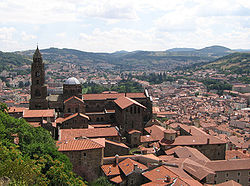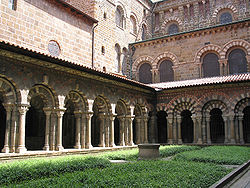
Le Puy Cathedral
Encyclopedia

France
The French Republic , The French Republic , The French Republic , (commonly known as France , is a unitary semi-presidential republic in Western Europe with several overseas territories and islands located on other continents and in the Indian, Pacific, and Atlantic oceans. Metropolitan France...
, in Le Puy-en-Velay
Le Puy-en-Velay
Le Puy-en-Velay is a commune in the Haute-Loire department in south-central France.Its inhabitants are called Ponots.-History:Le Puy-en-Velay was a major bishopric in medieval France, founded early, though its early history is legendary...
, Auvergne
Auvergne (région)
Auvergne is one of the 27 administrative regions of France. It comprises the 4 departments of Allier, Puy de Dome, Cantal and Haute Loire.The current administrative region of Auvergne is larger than the historical province of Auvergne, and includes provinces and areas that historically were not...
. It has been a centre of pilgrimage in its own right since before the time of Charlemagne
Charlemagne
Charlemagne was King of the Franks from 768 and Emperor of the Romans from 800 to his death in 814. He expanded the Frankish kingdom into an empire that incorporated much of Western and Central Europe. During his reign, he conquered Italy and was crowned by Pope Leo III on 25 December 800...
, as well as forming part of the pilgrimage route to Santiago de Compostela
Santiago de Compostela
Santiago de Compostela is the capital of the autonomous community of Galicia, Spain.The city's Cathedral is the destination today, as it has been throughout history, of the important 9th century medieval pilgrimage route, the Way of St. James...
. Since 1998 it has been a UNESCO
UNESCO
The United Nations Educational, Scientific and Cultural Organization is a specialized agency of the United Nations...
World Heritage Site
World Heritage Site
A UNESCO World Heritage Site is a place that is listed by the UNESCO as of special cultural or physical significance...
, as part of the "Routes of Santiago de Compostela in France
World Heritage Sites of the Routes of Santiago de Compostela in France
In 1998, several sites in France were added to the UNESCO World Heritage Sites under the description: Routes of Santiago de Compostela in France....
".
It is the seat of the Bishop of Le Puy.
Building description
The cathedral forms the highest point of the city, rising from the foot of the Rocher Corneille, and contains architecture of every period from the fifth century to the fifteenth, which gives it an individual appearance. The bulk of construction however dates from the first half of the 12th century.Formerly, the visitor passed through a porch standing well out from the building and, after descending beneath the pavement, emerged by a stairway in front of the high altar; the principal stairway is now covered by a bold vaulting which serves as base for one half of the church.

Sandstone
Sandstone is a sedimentary rock composed mainly of sand-sized minerals or rock grains.Most sandstone is composed of quartz and/or feldspar because these are the most common minerals in the Earth's crust. Like sand, sandstone may be any colour, but the most common colours are tan, brown, yellow,...
and black volcanic breccia
Breccia
Breccia is a rock composed of broken fragments of minerals or rock cemented together by a fine-grained matrix, that can be either similar to or different from the composition of the fragments....
, is reached by a flight of sixty steps, and consists of three orders: the lowest composed of three high arcades opening into the porch, which extends beneath the first bays of the nave; above are three central windows that light the nave; above them are three gables, one the gable-end of the nave, flanked by two openwork screening gables. The south transept
Transept
For the periodical go to The Transept.A transept is a transverse section, of any building, which lies across the main body of the building. In Christian churches, a transept is an area set crosswise to the nave in a cruciform building in Romanesque and Gothic Christian church architecture...
doorway is sheltered by a fine Romanesque
Romanesque architecture
Romanesque architecture is an architectural style of Medieval Europe characterised by semi-circular arches. There is no consensus for the beginning date of the Romanesque architecture, with proposals ranging from the 6th to the 10th century. It developed in the 12th century into the Gothic style,...
porch. Behind the choir rises a separate Romanesque bell-tower in seven storeys.
The bays of the nave are roofed by octagonal cupolas, the cupola at the crossing forming a lantern; the choir and transepts are barrel vaulted.
The four galleries of the striking parti-coloured cloister
Cloister
A cloister is a rectangular open space surrounded by covered walks or open galleries, with open arcades on the inner side, running along the walls of buildings and forming a quadrangle or garth...
were constructed from the Carolingian
Carolingian
The Carolingian dynasty was a Frankish noble family with origins in the Arnulfing and Pippinid clans of the 7th century AD. The name "Carolingian", Medieval Latin karolingi, an altered form of an unattested Old High German *karling, kerling The Carolingian dynasty (known variously as the...
period to the twelfth century. It is connected to remains of 13th century fortifications that separated the cathedral precincts separated from the rest of the city. Near the cathedral, the 11-century baptistry of St. John is built on Roman foundations.
Pilgrimage

Blessed Virgin Mary (Roman Catholic)
Roman Catholic veneration of the Blessed Virgin Mary is based on Holy Scripture: In the fullness of time, God sent his son, born of a virgin. The mystery of the incarnation of the Son of God through Mary thus signifies her honour as Mother of God...
and a place of pilgrimage - Charlemagne
Charlemagne
Charlemagne was King of the Franks from 768 and Emperor of the Romans from 800 to his death in 814. He expanded the Frankish kingdom into an empire that incorporated much of Western and Central Europe. During his reign, he conquered Italy and was crowned by Pope Leo III on 25 December 800...
made the pilgrimage to Le Puy twice - which brought it great wealth and influence. Its treasures escaped the ravages of war repeatedly over the centuries until the French Revolution
French Revolution
The French Revolution , sometimes distinguished as the 'Great French Revolution' , was a period of radical social and political upheaval in France and Europe. The absolute monarchy that had ruled France for centuries collapsed in three years...
, when all were destroyed, including the ebony statue of Our Lady of Le Puy which had been a gift of Saint Louis
Louis IX of France
Louis IX , commonly Saint Louis, was King of France from 1226 until his death. He was also styled Louis II, Count of Artois from 1226 to 1237. Born at Poissy, near Paris, he was an eighth-generation descendant of Hugh Capet, and thus a member of the House of Capet, and the son of Louis VIII and...
.
Pilgrims starting their journey to Santiago de Compostela
Santiago de Compostela
Santiago de Compostela is the capital of the autonomous community of Galicia, Spain.The city's Cathedral is the destination today, as it has been throughout history, of the important 9th century medieval pilgrimage route, the Way of St. James...
gather to be blessed each morning. The cathedral has been a UNESCO
UNESCO
The United Nations Educational, Scientific and Cultural Organization is a specialized agency of the United Nations...
World Heritage Site
World Heritage Site
A UNESCO World Heritage Site is a place that is listed by the UNESCO as of special cultural or physical significance...
since 1998, as part of the "Routes of Santiago de Compostela in France
World Heritage Sites of the Routes of Santiago de Compostela in France
In 1998, several sites in France were added to the UNESCO World Heritage Sites under the description: Routes of Santiago de Compostela in France....
".

